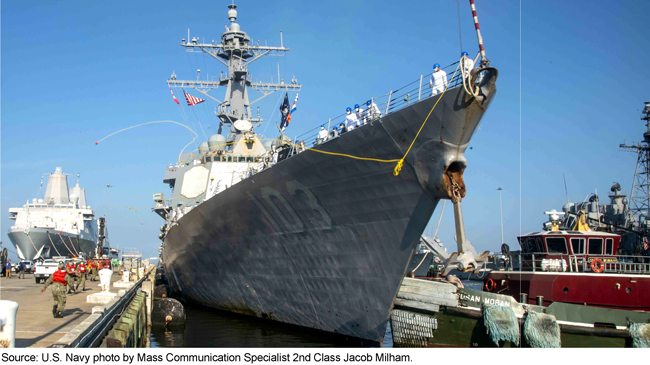Arleigh Burke Class Destroyers: Observations on the Navy's Hybrid Electric Drive Program
Fast Facts
The Navy initiated a program to reduce fuel consumption on its latest destroyers by installing Hybrid Electric Drive systems. Since 2011, the Navy has purchased six systems but has only installed one.
After spending over $100 million to develop, test, and produce these systems, we found that the Navy plans to suspend the HED program and pursue another research effort.
We could not assess the prudence of suspending the program because the Navy didn't fully assess the costs and benefits or complete testing of the HED system before making its decision.
The USS Truxtun is the only Navy ship with an installed Hybrid Electric Drive system.

Highlights
What GAO Found
In 2009, the Secretary of the Navy set goals to reduce fuel consumption and, 2 years later, initiated a program to install Hybrid Electric Drive (HED) systems on its fleet of Arleigh Burke class (DDG 51 Flight IIA) destroyers. The HED system draws surplus power from the ship's electric system and uses it to propel the ship. This allows the crew to turn off the propulsion engines and save fuel.
Since 2011, Navy officials told us that they have spent over $100 million on the development, purchase, and upgrade of six HED systems. In October 2018, the Navy completed installation of one of the systems on the USS Truxtun (DDG 103). However, the Navy has yet to install the remaining five HED systems and now plans to use them to support another research effort.
The Navy issued a January 2020 report to Congress on the HED system installed on the USS Truxtun, but did not include some requested information. For example, while the report included performance information from operations on board the USS Truxtun, it did not include sufficient information to determine the overall performance of the HED system. A comprehensive test and evaluation could have assessed the system's performance, reliability, and cyber survivability to inform program decision-making. Further, the report did not include a summary of planned investment that includes:
- an assessment of the costs and benefits of the HED system, or
- a projection of the funding needed to execute the program.
The Navy stated that it did not include a summary of the planned investments in the report because the HED program was not included in the President's fiscal year 2020 budget and also due to the need for additional HED data. However, Congress appropriated $35 million in funding for the HED program in 2020, which was available to support ship installation of the five previously purchased HEDs. The Navy stated that it can only use a small portion of this funding before it expires in September 2022 since the systems cannot be upgraded and incorporated into a ship's maintenance schedule in the next 3 years.
In summer 2020, Navy requirements officials informed GAO and Congress that they plan to suspend the HED program and send the five surplus HED systems to support research into a new electric motor, known as Propulsion Derived Ship Service (PDSS).
Navy requirements officials identified several reasons for suspending the HED program, but these reasons differ from information GAO obtained during the course of this review. For example:
- Navy officials stated that it is expensive to maintain the HED system. However, the commanding officer and crew of the USS Truxtun and senior Navy engineers stated that the system requires little maintenance.
- Navy officials also stated that the HED is not used very often in operations. According to the Navy's January 2020 report, the system was designed for low-speed operations (speed up to 11 knots), which comprise more than one-third of a typical DDGs operating profile.
GAO did not assess the Navy's decision to use the HED systems for PDSS research because the Navy did not have documentation regarding the requirements, testing, schedule, or costs of the PDSS effort. GAO could not determine the merits of suspending the HED program and using the other five HED systems for the PDSS effort because the Navy has yet to complete analysis that determines the costs, benefits, and performance necessary to support such a decision. If the Navy completes a further assessment—which has been requested by Congress—it could provide the information necessary to inform future decisions about the HED program.
Why GAO Did This Study
This report assesses the Navy's HED program. Senate Report 115-262 accompanying the John S. McCain National Defense Authorization Act for Fiscal Year 2019 asked the Navy to submit a report on the HED system installed on the USS Truxtun. GAO was asked to review the Navy's report and the Navy's recent decision to suspend the HED program to pursue the PDSS research project. This report (1) examines the extent to which the Navy's report on the USS Truxtun included information regarding the assessment areas as requested by Congress; and (2) describes the Navy's decision to suspend the HED program and use the HED systems for the PDSS research effort.
To conduct this work, GAO reviewed the Navy's 2020 report on the HED system, analyzed data and documentation the Navy used to guide investments, and assessed HED performance information. GAO also interviewed relevant Navy officials, such as the commanding officer and other senior crew of the USS Truxtun, and Navy engineers.
Recommendations
GAO is not making any recommendations.
